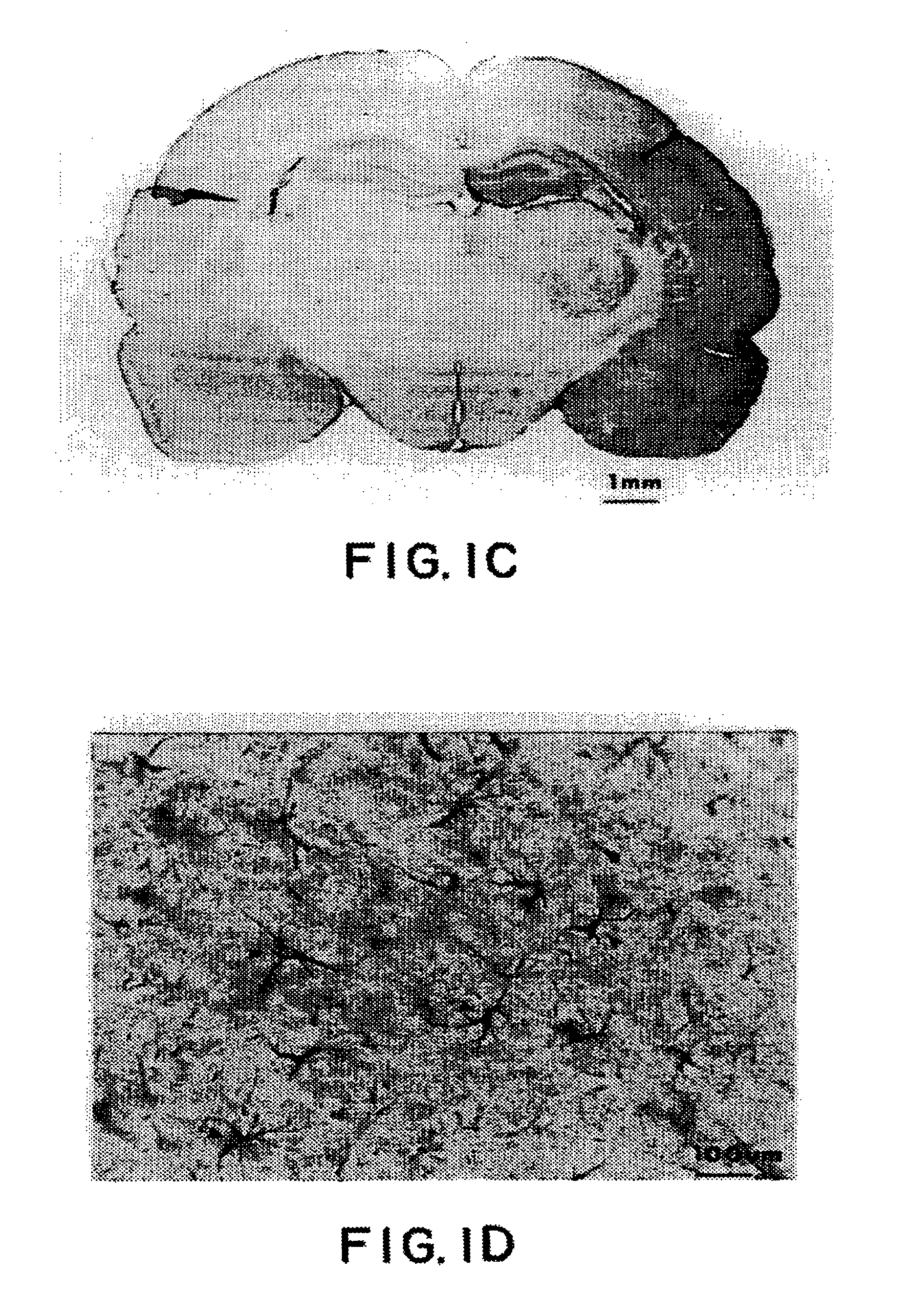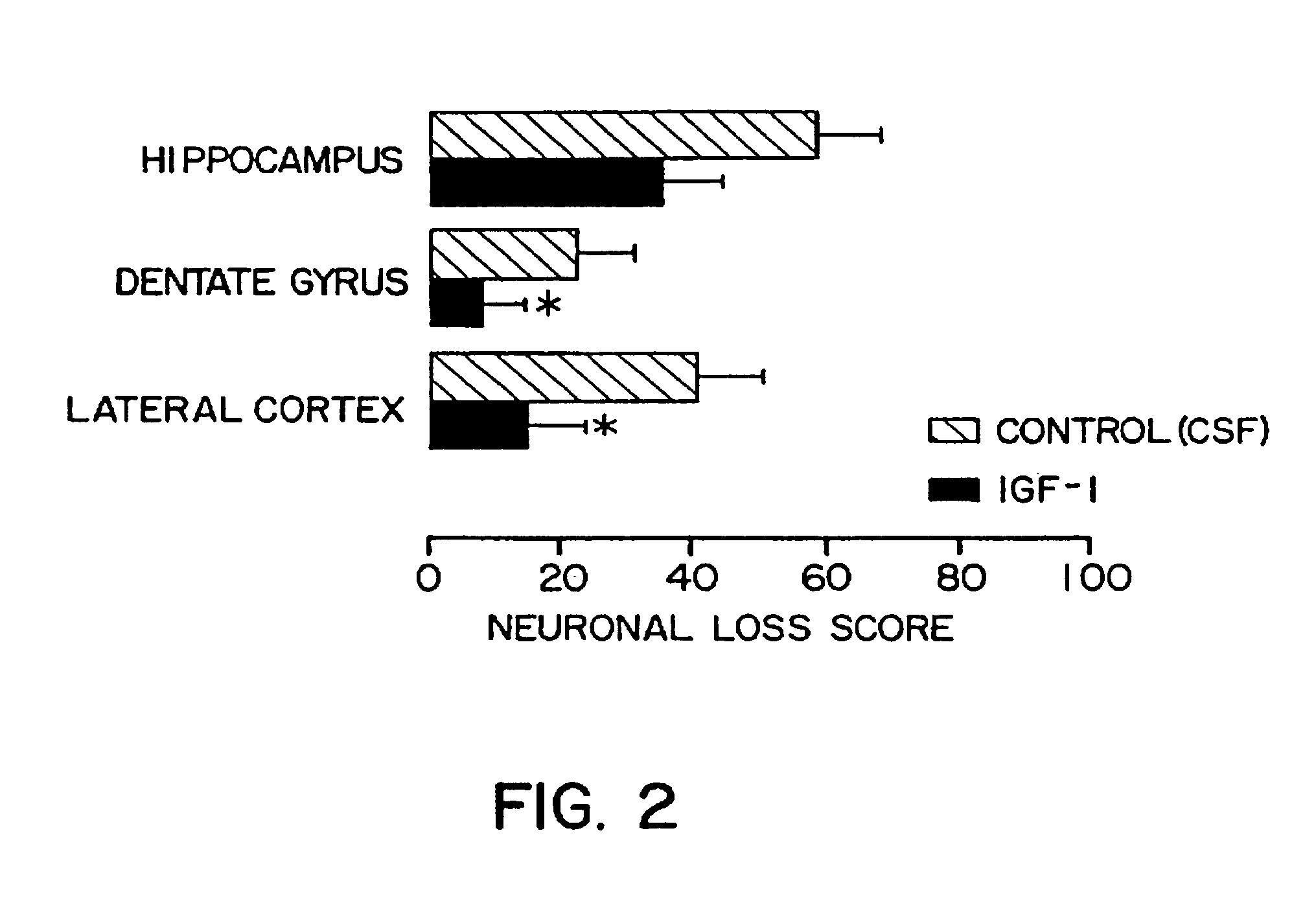IGF-1 to improve neural outcome
a neural outcome and igf technology, applied in the field of igf1 to improve neural outcome, can solve the problems of sensory, motor or cognitive deficit, loss of specific populations of cells, and damage in several different cell types, and achieve the effect of reducing the severity of cns damag
- Summary
- Abstract
- Description
- Claims
- Application Information
AI Technical Summary
Benefits of technology
Problems solved by technology
Method used
Image
Examples
example 1
[0074]The objective of these studies was to assess the effects of administering IGF-1 after a CNS insult. Adult rats (200-300 gm) were used. The experiments involved treating the rats with IGF-1 before and after a CNS insult. These rats had an hypoxic-ischemic insult to one cerebral hemisphere induced in a standard manner. One carotid artery was ligated and the animal was subjected two hours later to a defined period of inhalational hypoxia. The degree, length of hypoxia, ambient temperature and humidity were defined to standard(so the degree of damage. They were sacrificed five days later for histological analysis using stains (acid-fuchsin) specific for necrotic neurons.
[0075]In such experiments cell death typically is restricted to the side of the side of arterial ligation and is primarily in the hippocampus, dentate gyrus and lateral cortex of the ligated hemisphere.
experiment a
[0076]Unilateral hypoxic-ischemic injury was induced in adult 300±10 g) male Wistar rats. The rats underwent unilateral carotid ligation under light halothane anaesthesia. Following one hour recovery they were placed in an incubator at 31° C. and 85±5% humidity for one hour before insult. They were subjected to 10 min inhalational asphyxia (FiO2 6.0%) and maintained in the incubator for one hour after asphyxia.
[0077]Two hours after the termination of the inhalational insult, a single stereotaxically controlled lateral cerebroventricular injection of either 20 μg recombinant human IGF-1 or artificial cerebrospinal fluid (CSF) was given.
[0078]Recombinant hIGF-1 or diluent was prepared and administered to weight matched pairs as follows: Two hours after asphyxia the rats were given a light halothane anaesthetic, placed in a stereotaxic frame and a single ICV injection of either 10 μl of CSF (n=14) or 10 μl of CSF plus 20 μg IGF-1 (n=14) was given. Recombinant hIGF-1 (Genentech, South S...
experiment b
DISCUSSION OF EXPERIMENT B
[0097]Type 1 IGF receptors occur throughout the CNS on both neurons and glia with the highest density in the striatum and cortex (Lesniak et al 1988; Hill et al 1988). IGF-1 treatment reduced neuronal loss in all regions studied. This treatment also lowered the incidence of infarction indicating that loss of glial cells was reduced. These results agree with in vitro studies that indicate IGF-1 has potent trophic nonselective actions on neurons (Knusel et al 1990). Insulin has a much lower affinity for IGF receptors competing with IGF-1 only when at 100-fold higher concentrations (Gilmour et al 1988). Thus our results indicate that the neuroprotective effects, occur via IGF receptors (see FIG. 5). It is likely that the previously reported neuroprotective effects of insulin occur via the type 1 IGF receptor.
[0098]Many previously described neuroprotective strategies have been found to be indirectly effective by inducing hypothermia (Buchan, Pulsinelli, 1990). ...
PUM
| Property | Measurement | Unit |
|---|---|---|
| Time | aaaaa | aaaaa |
| Time | aaaaa | aaaaa |
| Body weight | aaaaa | aaaaa |
Abstract
Description
Claims
Application Information
 Login to View More
Login to View More - R&D
- Intellectual Property
- Life Sciences
- Materials
- Tech Scout
- Unparalleled Data Quality
- Higher Quality Content
- 60% Fewer Hallucinations
Browse by: Latest US Patents, China's latest patents, Technical Efficacy Thesaurus, Application Domain, Technology Topic, Popular Technical Reports.
© 2025 PatSnap. All rights reserved.Legal|Privacy policy|Modern Slavery Act Transparency Statement|Sitemap|About US| Contact US: help@patsnap.com



